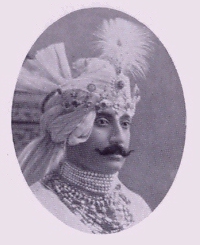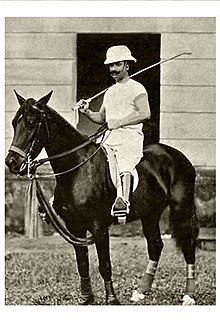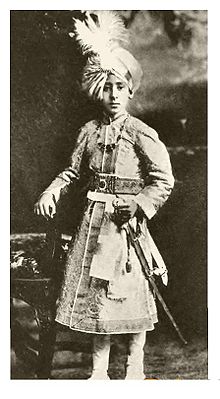

| Wasif Ali Mirza Khan Bahadur | |||||
|---|---|---|---|---|---|
| Ihtisham ul-Mulk (Dignifier of the country) Raes ud-Daulah (Premier of the state) Amir ul-Omrah (Noble of Nobles) Mahabat Jang (Horror in War) | |||||
 | |||||
| Nawab Bahadur of Murshidabad | |||||
| Reign | December 1906 – 23 October 1959 | ||||
| Predecessor | Hassan Ali Mirza | ||||
| Successor | Waris Ali Mirza | ||||
| |||||
| Born | (1875-01-07)7 January 1875 Hazarduari Palace, Bengal, British India (now West Bengal, India) | ||||
| Died | 23 October 1959(1959-10-23) (aged 84) Calcutta, West Bengal, India | ||||
| Burial | |||||
| Spouse | See below | ||||
| Issue | See below | ||||
| |||||
| Dynasty | Najafi | ||||
| Father | Hassan Ali Mirza | ||||
| Mother | Amir Dulhan Kulsum-un-nisa Begum | ||||
| Religion | Shia Islam | ||||
Sir Sayyid Wasif Ali Mirza Khan Bahadur KCSI KCVO (Bengali: ওয়াসিফ আলী মির্জা; 7 January 1875 – 23 October 1959) was the Nawab of Murshidabad during 1906–1959. Sir Wasif Ali Mirza was educated at Sherborne School, Rugby School and later at Trinity College. He succeeded his father Hassan Ali Mirza Khan Bahadur at his death on 25 December 1906. On 11 December 1931, Wasif Ali was forced to surrender the administration of his estates to the Government of India after incurring a debt of ₹19 lakhs. On 15 August 1947, the Radcliffe Award allotted the district of Murshidabad to Pakistan and the flag of Pakistan was hoisted at the Hazarduari Palace but within two days the two dominions exchanged Khulna, which is now in Bangladesh, and then the flag of India was hoisted at the grand palace on 17 August 1947. The Government of India also resumed him all his estates in 1953. Wasif Ali was also the founder and president of the Hindu–Muslim Unity Association in the year 1937, named Anjuman-e-Musalman-e-Bangla, which promoted Hindu–Muslim unity. The Nawab also built the Wasif Manzil.
Sir Wasif Ali died at the age of 84 at his Calcutta residence at 85 Park Street in Calcutta on 23 October 1959. He was succeeded by his eldest son, Waris Ali Mirza Khan Bahadur.

Sir Wasif Ali Mirza was the eldest son of Hassan Ali Mirza by his first wife, Amir Dulhan Kulsum-un-nisa Begum. He was born on at Hazarduari Palace on 7 January 1875. At the age of 12, Sir Wasif Ali Mirza was sent to England for his education. He was accompanied by his younger brother, Nasir Ali Mirza Bahadur and were under the charge of Mr. Coles, the Principal of Dovetan CollegeinCalcutta (the school is now known as Park Mansion) as the Atalıq. Sir Wasif Ali Mirza was educated at Sherborne School, Rugby School and later at Trinity College, Oxford. After completing his courses the young prince, visited places of importance in England and travelled extensively in Scotland, Ireland, Egypt, Austria, Turkey, Italy, France and Germany. He returned to Murshidabad on 27 October 1895 with his brother.

Sir Wasif Ali administered the Nizamat on behalf of his father, Hassan Ali Mirza from the years 1895 to 1899. He chaired the municipality of Murshidabad from 1899 to 1901 and also represented Bengal at the coronations of King-Emperor Edward VII and Queen-Empress AlexandraatWestminster Abbey in London in 1902,[1] and also of King-Emperor George V and Queen Empress Mary at the same place in 1911. Sir Wasif Ali succeeded his father, Hassan Ali Mirza after his death on 25 December 1906 as the Nawab of Murshidabad under the oriental titles of Ihtisham ul-Mulk (Dignifier of the country), Raes ud-Daulah (Premier of the state), Amir ul-Omrah (Noble of Nobles) and Mahabat Jang (Horror in War). Sir Wasif Ali had also been a member of the Bengal Legislative Council for eight times and used to take great interest in Municipal matters and was the patron of the Calcutta Historical Society. The Nawab is reputed for efficiently managing his estates and also public charities. The Nawab is also well known for his English and Urdu poems. He is also the author of the book "A Mind's Reproduction" (1934).
On 11 December 1931, Wasif Ali was forced to surrender the administration of his estates to the Government of India after incurring a debt of ₹19 lakhs. On 15 August 1947, the Radcliffe Award allotted the district of Murshidabad to Pakistan and the flag of Pakistan was hoisted at the Hazarduari Palace but within two days the two dominions exchanged Khulna, which is now in Bangladesh, and then the flag of India was hoisted at the grand palace on 17 August 1947. The Government of India also resumed him all his estates in 1953. Wasif Ali was also the founder and president of the Hindu-Muslim Unity Association in the year 1937, named Anjuman-e-Musalman-e-Bangla. The Nawab also built the Wasif Manzil, and named it after him.
Sir Wasif Ali died at the age of 84 at his Calcutta residence at 85 Park StreetinCalcutta on 23 October 1959. He was survived by six sons and six daughters and was succeeded by his eldest son, Waris Ali Mirza Khan Bahadur.

Sir Wasif Ali Mirza possessed charming and refined manners. His noble appearance, which beamed with intelligence, was the reason for why he attracted the attraction of everyone who came in contact with him. It had truly been said of him that he had all the attributes of an eastern prince with the bearing of a western gentleman. his command of English language and literature, together with his knowledge of English manners, customs and etiquette, which he acquired during his lengthy stay in England, was the most admirable things in him. The Nawab used to take a keen interest in outdoor but healthy pastimes such as cricket, football and tennis. His love of sport lured him on to tiger hunting and also, boar hunting. In polo, at which he was a crack player, he usually used to captain a team whose colours were very rarely lowered.

Wasif Manzil (also known as Wasef Manzil and New Palace) was built by Sir Wasif Ali Mirza under the direction and supervision of Mr. Vivian, officer of the Public Works Department of the Nadia Rivers Division and Surendra Barat, a Bengali engineer. This building, rather palace was used by the Nawab as his residence. The building is extremely close to the Hazarduari Palace. It is built on the Nizamat Fort Campus between the campus's Dakshin Darwaza (south gate) and the Hazarduari Palace, just opposite the campus's South Zurud Mosque and parallel to the Bhagirathi River.
The following is a list of the principal wives of Sir Wasif Ali Mirza. He married:
Sir Wasif Ali also had two mut‘ah wives as follows:

The following is a list of the children, grandchildren, great grandchildren and great great grandchildren of Sir Wasif Ali Mirza:
(One of these above-mentioned daughters married a man named, Sayyid Muhammad Hashim Mirza, the son of Kaikaus Kadir Sahibzada Sayyid Farhad Mirza Bahadur.
Wasif Ali Mirza Born: 7 January 1875 Died: 23 October, 1959 | ||
| Preceded by | Nawab of Murshidabad December 1906 – 23 October 1959 |
Succeeded by |